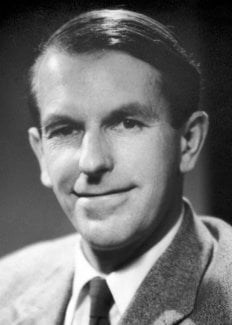Frederick Sanger
Biographical

Frederick Sanger was born on August 13, 1918, at Rendcombe in Gloucestershire, the second son of Frederick Sanger, M.D., a medical practitioner and his wife Cicely. He was educated at Bryanston School and at St. John’s College, Cambridge, where he took his B.A. degree in natural sciences in 1939. Since 1940 he has carried out research in the Department of Biochemistry at Cambridge. From 1940 to 1943 he worked with Dr. A. Neuberger on the metabolism of the amino acid lysine and obtained a Ph.D. degree in 1943. From 1944 to 1951 he held a Beit Memorial Fellowship for Medical Research and since 1951 he has been a member of the External Staff of the Medical Research Council. His present position is Head of the Division of Protein Chemistry in the M.R.C. Laboratory for Molecular Biology at Cambridge.
Since 1943 his work has been concerned largely with problems related to the determination of the structure of proteins. These studies resulted in the determination of the structure of insulin.
Sanger was awarded the Corday-Morgan Medal and Prize of the Chemical Society in 1951. In 1954 he became a Fellow of the Royal Society and a Fellow of King’s College, Cambridge. He is an Honorary Foreign Member of the American Academy of Arts and Sciences; Honorary Member of the American Society of Biological Chemists, Member of the Academies of Science of Argentina and Brazil, Honorary Member of the Japanese Biochemical Society, and Corresponding Member of the Association Qulmica Argentina.
In 1940, he married Margaret Joan Howe; they have two sons and one daughter.
This autobiography/biography was written at the time of the award and first published in the book series Les Prix Nobel. It was later edited and republished in Nobel Lectures. To cite this document, always state the source as shown above.
Addendum, May 2005
Following the work on insulin he developed further methods for studying proteins and particularly the active centres of some enzymes. Around 1960 he turned his attention to the nucleic acids, RNA and DNA. He developed methods for determining small sequences in RNA. The work culminated in the development of the “dideoxy” technique for DNA sequencing around 1975. This was a relatively rapid method and was used to determine the DNA sequence of the bacteriophage fx 174 of 5375 nucleotides in 1977, of human mitochrondrial DNA (16,338 nucleotides) and of bacteriophage l (48,500 nucleotides). The method has been improved and automated in other human genome (3 billion nucleotides).
Sanger retired in 1983.
Frederick Sanger received a second Nobel Prize in Chemistry in 1980.
Frederick Sanger died on 19 November 2013.
Copyright © The Nobel Foundation 2005Nobel Prizes and laureates
Six prizes were awarded for achievements that have conferred the greatest benefit to humankind. The 14 laureates' work and discoveries range from quantum tunnelling to promoting democratic rights.
See them all presented here.
